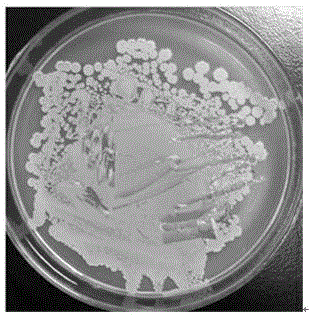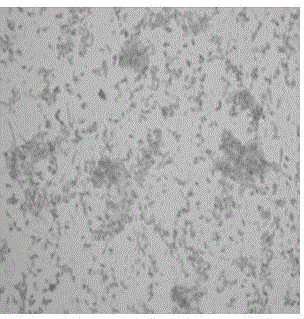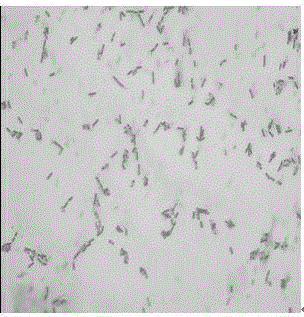Bacillus amyloliquefaciens separated from fermented soya beans and used for producing protease
A technology for decomposing starch spores and producing protease, which is applied in the field of bioengineering, and can solve the problems of uneven fermentation ability of wild strains, unstable product quality of fermented soy beans, product transportation and storage restrictions, etc., and achieve high production safety and high enzyme activity. High, easy separation and purification effect
- Summary
- Abstract
- Description
- Claims
- Application Information
AI Technical Summary
Problems solved by technology
Method used
Image
Examples
Embodiment 1
[0029] Embodiment 1: Preparation or screening of Bacillus amyloliquefaciens strain of the present invention
[0030] Step 1. Sample collection: collect fermented soybeans during the koji making process in the fermented soybean production factory, then seal them in sample bags and store them at low temperature.
[0031]Step 2. Enrichment culture: Take 1g of the sample and put it into a 10mL test tube, shake it with a vortex shaker for 5min, draw 1mL of the bacterial solution and place it in a 250mL Erlenmeyer flask with 50mL broth medium, and then place it in a 37±0.1 ℃, 72h in a shaker at 170r / min.
[0032] Step 3. Primary screening of strains: using the plate dilution method, take 200 μL of the enriched and cultured bacterial solution and spread it on the casein screening medium, cultivate it at 37±0.1°C for 48 hours, and pick out the strains that can produce transparent circles, among which , the casein screening medium of protease-producing Bacillus amyloliquefaciens is: c...
Embodiment 2
[0035] Embodiment 2: Microscopic morphology and molecular biological identification of Bacillus amyloliquefaciens strain of the present invention
[0036] The strain with the highest transparent circle was taken for microscopic morphology and molecular biology identification, and the specific process was as follows:
[0037] (1) Adopt solid plate culture method: solid culture is broth medium, cultivate at 37±1°C for 24 hours, and the colony diameter is 8-12mm. White opaque colonies, rough surface, irregular colony edges, no pigmentation on various media.
[0038] The microscopic morphological characteristics of Bacillus amyloliquefaciens are as follows: the bacterium is short rod-shaped, uniformly stained, motile, facultatively anaerobic, can form endophytic spores, the cysts are enlarged and oval, and the surface of free spores is weakly colored. Gram stain positive. Colony morphology of Bacillus amyloliquefaciens figure 1 , the micrographs of the spore morphology observe...
Embodiment 3
[0041] Embodiment 3: The Bacillus amyloliquefaciens strain 16S rDNA sequence analysis implementation process for protease production according to the present invention is as follows:
[0042] Primers were designed according to the most conserved sequence in bacterial 16S rDNA, in which the forward primer was F: 5'-GAGAGTTTGATCCTGGCTCAG-3', and the reverse primer was R: 5'-AAGGAGGTGATCCAGCCGCA-3'. PCR reaction system 20μL. Thermal cycle parameters Pre-denaturation at 94°C for 5min, denaturation at 94°C for 30s, annealing at 55°C for 40s, extension at 72°C for 1.5min, 35 cycles, and extension at 72°C for 7min. The PCR product was detected by agarose gel electrophoresis, and the amplified product was a specific band with a size of about 1.4kb. The amplified sequence was sequenced, and the 16S rDNA nucleotide sequence of the strain Jxnuwy-1 was 1457bp in size. The sequence was compared with the 16S rDNA nucleotide sequences of 10 strains in the GenBank database, and the strain wa...
PUM
 Login to View More
Login to View More Abstract
Description
Claims
Application Information
 Login to View More
Login to View More - R&D
- Intellectual Property
- Life Sciences
- Materials
- Tech Scout
- Unparalleled Data Quality
- Higher Quality Content
- 60% Fewer Hallucinations
Browse by: Latest US Patents, China's latest patents, Technical Efficacy Thesaurus, Application Domain, Technology Topic, Popular Technical Reports.
© 2025 PatSnap. All rights reserved.Legal|Privacy policy|Modern Slavery Act Transparency Statement|Sitemap|About US| Contact US: help@patsnap.com



